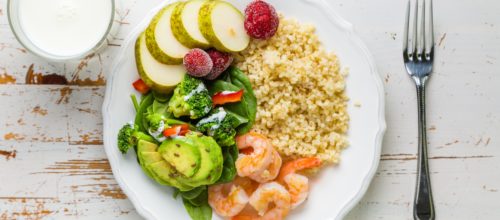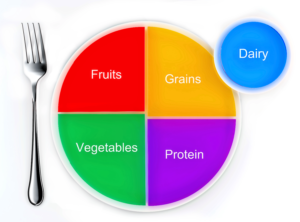
Choose MyPlate to Improve Health for Life
MyPlate depicts the key elements of a healthy diet. It emphasizes fruit, vegetable, grain, protein and dairy food groups. The goal of MyPlate is for people to think about building a healthy plate at mealtimes. This is a visual reminder to help consumers find a healthy eating style that fits their lifestyle. MyPlate recommendations allow you to still enjoy your food, while eating less and avoiding oversized portions. Establishing a healthier eating style can help to prevent becoming overweight, obese, or reduce your risk of developing diseases such as heart disease, diabetes and cancer.
Eating the MyPlate way means filling half your plate with fruits and vegetables, while filling the other half of your plate with lean protein and grains. You should aim to make at least half of the grains whole grains. This means choosing brown rice instead of white rice and whole wheat breads/pastas instead of white bread/pastas. Whole grain varieties of breads, cereals, rice and pasta have the greatest array of nutrients and more fiber than other foods in this groups. Although cakes, cookies and pastries are grain products, these foods are higher in calories, fat and sugar. They are also lower in fiber, vitamins and minerals.
Good sources of lean protein include chicken, turkey, tofu, fish, shellfish, beans, peas, eggs, and lean cuts of beef, lamb and pork. Lean protein is lower in saturated and trans fat, which can prevent raising cholesterol levels and reduce the risk of developing heart disease.
Aim to eat a variety of fruits and vegetables because they all contain different amounts and types of nutrients. It is better to eat a whole piece of fruit instead of fruit juice because the nutrients are intact and the fiber will keep you feeling full. Many fruit juices that are sold in supermarkets contain only a small percentage of real fruit juice and are packed with added sweeteners. Therefore, it can be easy to consume a lot of calories without getting any actual nutrition.
You should look for foods and drinks that are lower in saturated fat, added sugars and sodium. This can help to manage your calories and prevent you from becoming overweight or obese. You should also try to switch to fat-free (skin) or low-fat (1%) dairy products.
Based on energy needs of an individual, MyPlate has made recommendations for daily amounts to consume from each food group. For the average 2,000 calorie diet, one should aim to have 6 ounces of grains, 2 1/2 cups of vegetables, 2 cups of fruit, 2 1/2 to 3 cups of dairy and 5 1/2 ounces of protein per day. Saturated fat should stay under 22 grams per day and added sugars should not exceed 50 grams per day.
Variety is key to getting the array of nutrients offered by each food group because different foods provide different types and amounts of key nutrients. It is important to keep your portion sizes under control, so that you can eat a balanced and varied diet without consuming more calories, fat, cholesterol, sugar and sodium than you need. Portion control may be difficult for many people; however, it does not have to mean deprivation and misery. You do not have to elimate your favorite foods completely. Focus on choosing smaller servings of high-fat or high-sugar foods that you enjoy such as regular soft drinks or chocolate. Overall, you should strive for smaller serving sizes of some foods and try to include mostly nutient dense foods.
References:
https://www.choosemyplate.gov/WhatIsMyPlate
https://www.webmd.com/food-recipes/guide/myplate-food-groups-and-portions
Berning, J., Byrd-Bredbenner, C., Kelley, D., & Moe, G. (2019). Wardlaws Perspectives in Nutrition(11th ed.). New York, N.Y: McGraw-Hill.

